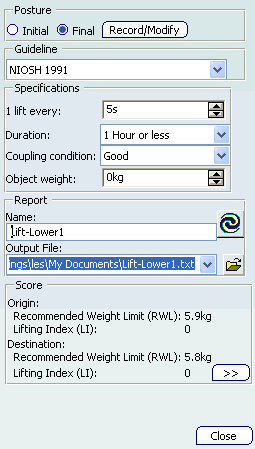Concepts of the Lift-Lower Analysis | ||
| ||
The Lift-Lower Analysis dialog box.

The Dialog box:
| Command | Description | |
|---|---|---|
| Posture |
This area of the dialog box has two functions:
|
|
| Guideline | From this list, select the guideline to perform the lift-lower analysis. The guidelines available are NIOSH 1981, NIOSH 1991, and Snook & Ciriello. The Specifications and Scores change depending on which guideline is selected.
|
|
| NIOSH 1981 |
Specifications:
Score Immediately after the frequency and duration fields are completed, the results are displayed in the Score zone.
|
|
| NIOSH 1991 |
Specifications
Score Immediately after the frequency and duration fields are completed, the results are displayed in the Score zone.
Today in the Human Activity Analysis workbench, the NIOSH 1991 Lift/Lower analysis outputs the Recommended Weight Limit (WRL), and the Lifting Index (LI) in the Score section of the Lift/Lower Analysis . You are able to easily view the various multipliers (intermediate results) that are used in the NIOSH 1991 Lifting Equation, and to copy/paste them in another text editor, for future reference. The goal here is to provide more pertinent information. To attain these results of recommended weight limit and lifting index from the manikin posture, we use the equations prescribed in the literature regarding the NIOSH 1991 study. The text below presents these equations. But because these factors carry substantial information on their own, and because this information is supplemental to the information given by the final output (WRL and LI), there is a need to display these values as well. This way, you can be fully informed of a particular factor change, say the frequency multiplier, and can appreciate precisely how any of the intermediate factors influences the final result. The following two equations are taken verbatim from the brochure entitled: "Applications Manual for the Revised NIOSH Lifting Equation", U.S. Department of Health and Human Services, Cincinnati, Ohio, January 1994: RWL = LC * HM * VM * DM * AM * FM * CM LI = L over RWL Here, we see that a few intermediate variables ("LC", "HM", and so on) are needed, and calculated internally, in order to produce the two main results of the analysis. These variables are:
This way, you can be fully informed of a particular factor change, say the frequency multiplier, and can appreciate precisely how any of the intermediate factors influences the final result. As this lack of information prevents you from understanding how the analysis operates. |
|
| Snook & Ciriello |
Specifications:
Immediately after the frequency and population sample fields are completed, the results are displayed in the Score zone.
|
|
| Report | See Reporting Capabilities - Updating | |
See also: Analysis IntroductionLift-Lower Analysis







